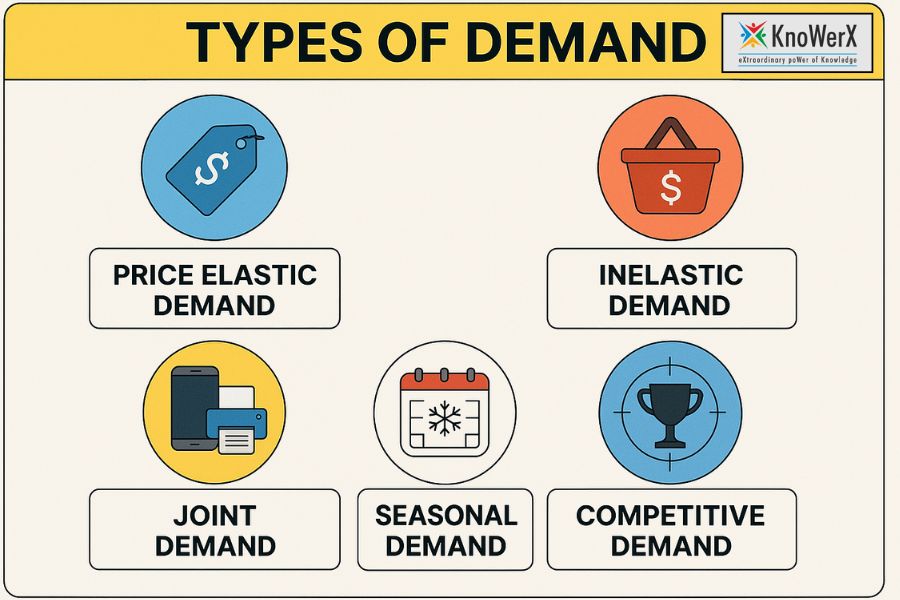These Types of Demand Are Driving Massive Profits!
Behind every successful business lies one powerful force demand. It’s the engine that drives sales, shapes strategy, and fuels profitability. But not all demand is created equal. From price-sensitive buyers to seasonal spikes and industry-driven needs, understanding the different types of demand is key to unlocking business growth.

In this article, we’ll explore the most profitable demand types, reveal how businesses turn them into revenue streams, and show how supply chain professionals can use this knowledge to gain a competitive edge especially with guidance from KnoWerX, a leader in supply chain management education.
1. The Hidden Power of Demand
Demand is the lifeblood of every business. Without demand, there is no reason to produce, no sales to make, and ultimately, no revenue to count. It is the unseen engine behind profits.
There are various types of demand, each with its own influence on sales strategy. These include price elasticity, seasonality, and even competition-based demand — all crucial to how products perform in the market.
Understanding and harnessing different types of demand can be a game-changer. Businesses that tailor their offerings and marketing based on dem and patterns often see faster growth, better customer retention, and higher margins.
2. Breaking Down the Most Profitable Types of Demand
Here, we identify six highly impactful demand types and how businesses can strategically respond to each.
1 – Price Elastic Demand
Consumers are highly sensitive to price changes in this type of demand. Lowering prices even slightly can lead to a significant increase in sales volume.
Profit strategy: Leverage tactics like limited-time discounts, flash sales, and penetration pricing. These techniques attract price-sensitive customers, especially in competitive or commoditised markets.
2 – Inelastic Demand
Here, consumers continue to buy regardless of price fluctuations. These are often necessities or products with few substitutes, like medicine or fuel.
Profit strategy: Adopt premium pricing, especially for essential or high-value items. Margins can be maintained or increased without fearing a drop in demand.
3 – Derived Demand
This demand exists because of the demand for another product or service. For example, the demand for steel arises from the demand for construction and automobiles.
Profit strategy: Position your business within the B2B supply chain to benefit from upstream or downstream demand. Anticipate industry trends to align offerings with growth sectors.
4 – Joint Demand
Products are often used together, so demand for one boosts the other. Printers and ink cartridges, or smartphones and protective cases, are classic examples.
Profit strategy: Create product bundles or offer upsells that add value. This not only boosts average order value but also enhances customer satisfaction by delivering complete solutions.
5- Seasonal Demand
Consumer interest surges during specific periods, such as holidays or weather changes. Think of ski gear in winter or air conditioners in summer.
Profit strategy: Plan seasonal promotions well in advance and manage inventory smartly. Capitalising on high-demand windows can lead to a spike in revenues while minimising overstock risks.
6 – Competitive Demand
Occurs when multiple products or brands satisfy the same need. For instance, Coke and Pepsi compete for the same consumer base.
Profit strategy: Focus on brand differentiation, unique features, and emotional connections. Strong brand positioning can tip customer preference in your favour even in crowded markets.
3. How Businesses Turn Demand Types into Revenue Machines

Successful businesses analyse consumer behaviour and evolving market trends. By doing so, they can match the right demand type to the right product or service strategy.
Product development, pricing, and promotions must align with identified demand types. Whether through seasonal offerings or competitively priced innovations, aligning business decisions with demand can drive long-term revenue.
Real-world case study: Consider how Starbucks uses seasonal demand (e.g., Pumpkin Spice Latte) and competitive demand (customisable coffee vs local cafés) to stay ahead. Their agile marketing and limited-time offers keep customers engaged year-round.
4. Adapting Your Business to Maximise Demand-Based Profits
Invest in demand forecasting tools and advanced analytics to anticipate trends. Knowing when and how much customers will buy empowers smarter inventory, staffing, and pricing decisions.
Marketing and sales efforts must be tailored to match the specific type of demand your product faces. For example, promotional campaigns should target price-sensitive consumers if your product faces elastic demand.
Agility and innovation are key to surviving and thriving in demand-driven markets. Rapidly iterating on product features, bundles, or pricing models can help you capitalise on emerging demand types and outpace competitors.
5. The Role of Innovation in Shaping Demand Types
Innovation doesn’t just respond to demand — it creates it. Companies that consistently innovate can shift consumer behaviour and even invent entirely new types of demand.
Disruptive products often turn latent demand into mainstream markets. Think of how Netflix transformed the entertainment industry by responding to unmet desires for convenience and choice.
Technology-driven businesses use R&D to unlock price-inelastic or joint demand. For example, smart homes combine hardware and software into bundles, enhancing long-term customer value.
6. Common Mistakes Businesses Make with Demand Strategy
One-size-fits-all pricing often fails in markets with varying demand types. Businesses that ignore elasticity risk losing customers or underpricing high-demand products.
Failing to align inventory with seasonal or derived demand leads to missed profits. Overstocking or stockouts can harm brand trust and create operational inefficiencies.
Misreading competitive demand can weaken brand positioning. Brands that don’t differentiate may be viewed as interchangeable and get lost in price wars.
Frequently Asked Questions
What are the most profitable types of demand for businesses?
The most profitable demand types include price elastic demand, inelastic demand, derived demand, joint demand, seasonal demand, and competitive demand. Each offers unique opportunities for pricing, bundling, and promotional strategies.
Why is understanding Supply Chain Maturity important?
It helps businesses optimise operations, reduce costs, and improve responsiveness to market changes.
What is derived demand in business?
Derived demand refers to the demand for a product that stems from the demand for another product or industry. For example, increased automobile production boosts demand for tyres and steel.
How can businesses leverage seasonal demand?
By planning promotions and inventory around predictable peak periods (e.g., holidays or weather shifts), businesses can maximise sales and reduce stock issues.
Ending Remark

At KnoWerX, we understand that recognising and responding to different types of demand is the cornerstone of any successful supply chain strategy. In today’s fast-paced and competitive market, businesses can no longer rely on one-size-fits-all approaches. They need professionals who can interpret demand patterns — whether price elasticity, seasonal surges, or derived and competitive demand — and translate them into actionable, profit-driving decisions.
Our courses are designed to equip supply chain leaders with the tools and insights needed to forecast accurately, optimise inventory, and align operations with real market needs. Through frameworks, real-world case studies, and demand forecasting tools, KnoWerX helps you transform demand understanding into a strategic advantage.
Image Reference: Freepik
Disclaimer: All trademarks, logos, and brand names are the property of their respective owners. All company, product, and service names used in this website are for identification purposes only. Use of these names, trademarks, and brands does not imply endorsement.



